Saint Juan Diego-Messenger of Our Lady
In April of 1990 Juan Diego was declared Blessed by Pope John Paul II at the Vatican. The following month, in the Basilica of Our Lady of Guadalupe in Mexico City, during his 2nd visit to the shrine, John Paul II performed the beatification ceremony.
The summer of 2002, Juan Diego was canonized a Saint.
The Holy Father flew to Mexico City after World Youth Day 2002 in Toronto in July 31. It was his 5th visit to the Basilica of Our Lady of Guadalupe.
Pope John Paul II praised Juan Diego for his simple faith nourished by catechesis and pictured him (who said to the Blessed Virgin Mary: "I am a nobody, I am a small rope, a tiny ladder, the tail end, a leaf") as a model of humility for all of us.
The life of Juan Diego bridges two cultures: precolumbian, which praises false gods, sacrifices human lifes and past-conquest with faith in one true God, announcing end of life sacrifices for idols.
Who was Juan Diego?
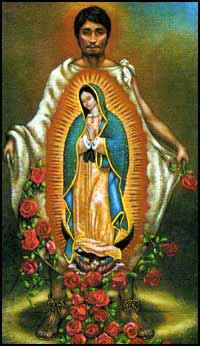
It is recorded that he was working hard in field and was the maker of mats. He owned a piece of land and had a house.
Juan Diego was happily married but he and his wife had no children. He was a very devoted man and soon he and his wife converted to the faith of the Christians. They were baptized into the Catholic Church by Franciscan Fray Peter da Gand, one of the first missionary. It happen in or around 1524 - 1525 when st. Juan Diego was in age 50. He took on the name of Juan Diego and his wife became, Maria Lucia.
According to the first formal investigation by the Church about the events, the Informaciones Guadalupanas of 1666, Juan Diego seems to have been a very devoted, religious man, even before his conversion. He was a solitary, mystical character, prone to spells of silence and frequent penance and used to walk from his village to Tenochtitlan, 14 miles away, to receive instruction on the doctrine.
His wife Maria Lucia became sick and died in 1529. Juan Diego then moves to live with his uncle Juan Bernardino in Tolpetlac, which was closer (9 miles) to the church in Tlatelolco -Tenochtitlan. Gdy mówił do Matki Bożej nazywał siebie "nikim" i był świadomy, że nie jest godny zaufania ze strony Biskupa, gdy doszło do spotkania z nim.
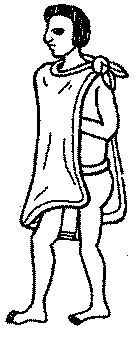 He walked every Saturday and Sunday many miles to church, departing early morning, before dawn, to be on time for Mass and religious instruction classes. He walked on naked feet, as all the people of his class, the macehualli. Only the higher social classes of the Aztecs wore cactlis, or sandals, made with vegetal fibers or leather. He used to wear in those chilly mornings a coarse-woven cactus cloth as a mantle, a tilma or ayate made with fibers from the maguey cactus. Cotton was only used by the upper Aztec classes.
He walked every Saturday and Sunday many miles to church, departing early morning, before dawn, to be on time for Mass and religious instruction classes. He walked on naked feet, as all the people of his class, the macehualli. Only the higher social classes of the Aztecs wore cactlis, or sandals, made with vegetal fibers or leather. He used to wear in those chilly mornings a coarse-woven cactus cloth as a mantle, a tilma or ayate made with fibers from the maguey cactus. Cotton was only used by the upper Aztec classes.
During one of this walks to Tenochtitlan, which used to take about three and a half hours between villages and mountains, the First apparition occurred (See The Event of Apparition page), in a place that is now known as the "Capilla del Cerrito", where the Blessed Virgin Mary talked to him in his language, Nahuatl. She called him "Juanito, Juan Dieguito ", "the most humble of my sons", "my son the least", "my little dear".
He was 57 years old, certainly an old age in a time and place where the male life expectancy was barely above 40.
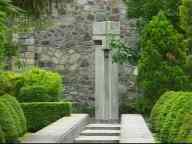
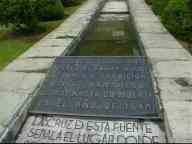
Tradition holds, that this is a place of hermitage life of Juan Diego from 1531 to death.
He died on May 30, 1548, at the age of 74.
Juan Diego deeply loved the Holy Eucharist, and by special permission of the Bishop he received Holy Communion three times a week, a highly unusual occurrence in those times.
Pope John Paul II praised Juan Diego for his simple faith nourished by catechesis and pictured him (who said to the Blessed Virgin Mary: "I am a nobody, I am a small rope, a tiny ladder, the tail end, a leaf") as a model of humility for all of us.
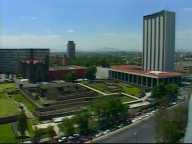
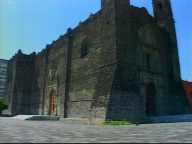
The church, where Juan Diego took doctrines and was baptized.
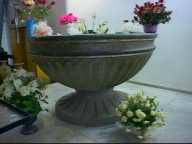
This is the font, where st. Juan Diego was baptized.
Saints of the Universal Church
Juan Diego is 464th Saint declared by Pope John Paul II. The Pontificate of our Pope is so fruitful in giving out to the Church new encouraging models of saint life, that we know John Paul II of declaring more Saints than all Predecessors in Papacy.This so called readiness for canonisation is in service of evangelisation fervour. Holy Father wishes to raise to the dignity of Altar people from the highest number of nationalities, ethnic groups, poor people, people from all classes, to give an example of universality of Catholic Church.
Holy Father performed nearly 1500 of beatifications.
Holy Father wants to show before the world, that sainthood isn't something far for today's people, because durring His Pontificate John Paul II canonized and beatifized people from different social spheres. And that is the way to show always actual call of Christ: "Be holy as holy is your Father, who art in heaven".
John Paul II in Apostolic Letter 'Nuovo Millenio Inneunte' has written (not accurate translation from polish):
"I give thanks to God, that He allowed me during past years to beatifize and canonize so many christians, and between them a high number of lay faithful, who made themselves saint in the most ordinary opportunities of life. Today from the beginning one must recommend with conviction this aspiration to this high range of ordinary christian life."
The habit of devotion to the Saints in Church lasts from the first ages of christianity. Then martyrs were glorified and asked for intercession before God. In year 156 A.D. christians say in letter about martyrdom death of their bishop st. Policarp.
It reads: "We pray to Christ, because He is a Son of God. We love martyrs as disciples and followers of Lord."
Existing for today directive of the Church which tells about placing relics of Saints inner Altars (where Holy Mass is celebrated) is a continuation of tradition of celebrating the Holy Mass in place, where martyr was buried.
Above cited Smyrna christian's letter says in those words about rests of corpse of their bishop, Martyr:
"They (the rests) are dearest for us than jewel stones and beloved much than gold. We keep them in the right place, we will gather ourselves for joyful solemnities and to celebrate anniversary of his martyrdom."
The first official proclamation of sainthood was related with bishop Ulrich from Augsburg, in 993 year. Saints, who practised sainthood in convincing manner, heroic recognized by Church, are special representative of Church. Their example makes it clear to read, what is the Church. They are authentic sign of its sanctity, they consist of measure and a model of christian life altogether, because they are with us a part of one Body of Christ. We can ask them for intercession - this is the second dimention of this proclaming sanctity of witnesses, servants of God. They are for us those, on who we can very count.
Why was Juan Diego being canonized 454 years after his death?
First, because canonical legislation established at the time of Urban VIII, more precisely in 1635, discouraged the introduction of processes of canonization in general. The few causes that were initiated were those of great founders of institutes or religious works, or great figures, often supported by monarchies or by other religious authorities.We must also remember that Juan Diego was an Indian. In the past, the causes of great founders were introduced, such as St. Ignatius of Loyola; of great missionaries, such as St. Francis Xavier; and of great mystics, such as St. Teresa of Avila. However, no one ever thought of canonizing an Indian.
The Apparitions and Mission
Our Lady was true to her promise and manifested her Son to the millions of indigenous people who converted to Him. For the next seventeen years Juan lived as a humble hermit in a hermitage at the base of Tepeyac Hill and cared for the nearby church that housed the tilma.Since Juan was learned in Nahuatl and Christian doctrine, he was able to explain the Miraculous Image on the tilma that spoke to the natives as a pictograph. He explained its significance and the story of the apparitions over and over again. He spent hours in prayer to Jesus and Mary and cared for her Image. He lived a life of poverty, chastity and obedience and was revered by all. He died in 1548 at the age of 74 and was probably buried in his hermitage next to the chapel that he had cared for so well.
Virtues of st.Juan Diego
Juan Diego is a saint not because Our Lady appeared to him, but because he exercised heroic virtues. In his beatification address, Pope John Paul II praised Juan's virtues, "his simple faith, nourished by catechesis and open to the mysteries; his hope and trust in God and in the Virgin; his love, his moral coherence, his unselfishness and evangelical poverty."Living the life of a hermit here near Tepeyac, he was a model of humility. The Virgin chose him from among the most humble as the one to receive that loving and gracious manifestation of hers which is the Guadalupe apparition. Her maternal face and her blessed image which she left us as a priceless gift is a permanent remembrance of this. In this manner she wanted to remain among you as a sign of the communion and unity of all those who were to live together in this land. . . .
"Juan Diego too shines before you, raised by the Church to the honors of the altar; we can invoke him as the protector and the advocate of the indigenous peoples."
Juan exhibited the Marian virtues of humility, obedience, charity, trust, patience, poverty and chastity.
Like Mary, who saw herself as the lowly handmaid of the Lord, Juan saw himself as a mecapalli, a burden-bearer. Like Mary, who obeyed and accepted to be a mother to carry Christ, Juan obeyed and accepted to be the messenger of Mary to "carry her breath." Like Mary, who in charity cared for her elderly pregnant cousin Elizabeth, Juan cared for his elderly dying uncle, Juan Bernadino. Like Mary, who "trusted that the Lord's promise to her would be fulfilled" (Lk 1:45), Juan trusted Our Lady's promise that there were flowers at the top of the hill and he climbed it in trust. Like Mary, Juan trusted Our Lady's promise that the Bishop would recognize her will and fulfill it in the sign of the flowers. Like Mary, who patiently waited for nine months for the Lord's promise to be fulfilled, Juan patiently waited for days for Our Lady's promise to be fulfilled. Like Mary, who lived in poverty and chastity as a widow, Juan, the widower, gave up his possessions and lived in poverty and chastity until his death. Finally, like Mary, Juan didn't argue with God's will, he didn't complain and he didn't doubt.
Lay Apostle
The Apostle is a man, who is sent to people as messenger of God. St. Juan Diego was a layman, who was an apostle for Mexico, and as so he is a model for Lay Apostolate, for those who support evangelisation, because the Queen of Apostles has sent him as messenger of God. The success of his mission can be measured through its fruits. 8 millions of native Mexicans converted to true God durring the seven years. Human sacrifices has been stopped, and natives concerned themselves with the situation of being conquered by Spaniard conquerors.Because of its fast progress it was the largest evangelisation in the history of the world.
Juan Diego was a model lay apostle who foreshadowed those described in The Decree on the Apostolate of the Laity of the Second Vatican Council. In his person and mission he understood the power of God, the intercession of Mary and her love for all mankind to whom she leads her Son. Juan may become known as one of the great saints in the history of the Church. He should be recognized as something of a Patriarch, like Abraham or Moses. Of course, he didn't lead thousands to the Promised Land but he led millions to the Promised One through the intercession of Our Lady of Guadalupe.
Pope John Paul II said at his beatification ceremony, "Similar to ancient Biblical personages who were collective representations of all the people, we could say that Juan Diego represents all the indigenous peoples who accepted the Gospel of Jesus, thanks to the maternal aid of Mary, who is always inseparable from the manifestation of her Son and the spread of the Church, as was her presence among the Apostles on the day of Pentecost.
"The recognition of the veneration that has been given for centuries to the layman, Juan Diego, assumes a particular importance. It is a strong call to all the lay faithful of the nation to assume all their responsibilities in the transmission of the Gospel Message and in the witness of a living and operative faith. . . .
"The lay faithful share in the prophetic, priestly and royal role of Christ (cf. Lumen Gentium, 31), but they carry out this vocation in the ordinary situations of daily life. Their natural and immediate field of action extends to all the areas of human coexistence and to everything that constitutes culture in the widest and fullest sense of the term."
Juan Diego is the model for the lay apostolate and like him all of the lay faithful are called to be witnesses to spread our own personal roses of humility, obedience, charity, trust, and patience in our own time and place.
"The mission of the Church pertains to the salvation of men, which is to be achieved by belief in Christ and by His grace. The apostolate of the Church and of all its members is primarily designed to manifest Christ's message by words and deeds and to communicate His grace to the world." (Decree on the Apostolate of the Laity ch. 2, no. 6). The Queen of the Apostles, Our Lady of Guadalupe, and her apostle Juan Diego carried out this mission to the greatest degree known in the history of the world.
"Whether the lay apostolate is exercised by the faithful as individuals or as members of organizations, it should be incorporated into the apostolate of the whole Church according to a right system of relationships. Indeed, union with those whom the Holy Spirit has assigned to rule His Church (cf. Acts 20.28) is an essential element of the Christian apostolate." (Decree on the Apostolate of the Laity ch. 5, no. 23).
Juan Diego received the mission. Mary called him and sent him with her words, "I urge you to go to the Bishop . . ." The Holy Spirit anointed Juan as an individual but he exercised his role in union with the whole Church through his Bishop just as the Council requested over 400 years later.
The Holy Spirit usually breathes in less dramatic ways. But the experience of Juan Diego shows that the inspirational grace for a great work may first come to a layperson who then cooperates with the hierarchy. Because he did so, it is appropriate that he is the model for the lay apostolate. His life story exemplifies the meaning of the lay apostolate. He led the indigenous peoples to their spiritual mother who in turn led them to her Son. He is truly worthy to be The Model for the Lay Apostolate because he was the only person on earth to whom the greatest laywoman of all time gave her own Image.
Intercessor of Miracles
On May 6, 1990, at the very moment the Holy Father was proclaiming Juan Diego Blessed, Juan José Barragán Silva, a drug addict in his twenties stabbed himself with a knife at home in Mexico City in his mother's presence and went to a balcony to jump from the window.His mother, Esperanza, tried to hold him by the legs, but he freed himself and plunged thirty feet head-first to the ground. He then was rushed to the intensive care unit of Durango Hospital in Mexico City.
Esperanza said that when her son was falling she entrusted him to God and Our Lady of Guadalupe. She invoked Juan Diego and implored, "Give me a proof . . . save this son of mine! And you, my Mother, listen to Juan Diego."
Suddenly and inexplicably, three days after the fall, her son was completely cured. Subsequent examinations confirmed that he had no neurological or psychic effects, and the doctors concluded that his cure was "scientifically inexplicable."
Medical experts said the youth should have died in the fall, or at least been left seriously handicapped. J.H. Hernández Illescas, regarded internationally as one of the best specialists in the field of neurology, and two other specialists, described the case as "unheard of, amazing, and inconceivable."
This miracle was the decisive factor in the recognition of Juan Diego's sainthood. Our Lady promised Juan that she would reward him for his efforts on her behalf. She told him, "Yes, I will enrich you, I will glorify you." Her promise has been fulfilled. Pope John Paul II canonized Juan on July 30 in Mexico City. His Feast Day is December 9.
Juan Diego May Have Been More Than a Visionary. Was Reconciler of Cultures, Says Mexican Primate
MEXICO CITY, MAY 30, 2002 (Zenit.org).- Guadalupe visionary Juan Diego was a mediator and reconciler between Indian and European cultures, as well as a Gospel messenger, the archbishop primate of Mexico says in a new book.The book, "Juan Diego the Talking Eagle," addresses historical aspects of the Mexican Indian, who received messages from the Blessed Virgin in December 1531, and who will be canonized July 31 in the Basilica of Our Lady of Guadalupe.
At a press conference this week to present his book, Cardinal Norberto Rivera Carrera pointed out that many questions still surround the historical figure of Blessed Juan Diego.
But there are no longer any doubts in regard to his Indian nature, virtues, historicity and holiness, the archbishop primate said.
